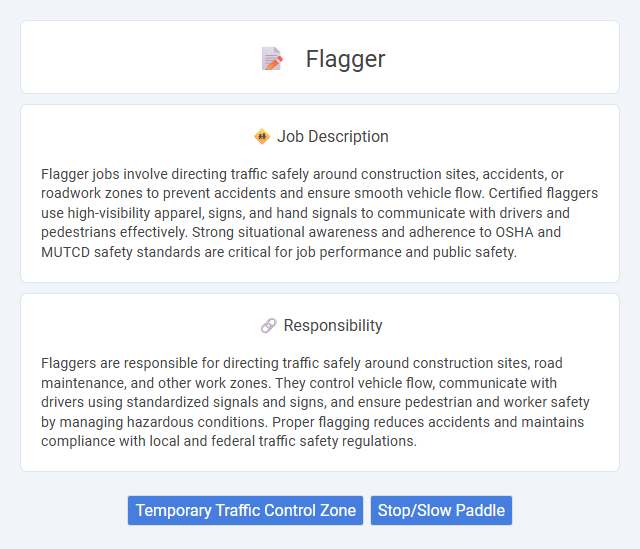
Flagger jobs involve directing traffic safely around construction sites, accidents, or roadwork zones to prevent accidents and ensure smooth vehicle flow. Certified flaggers use high-visibility apparel, signs, and hand signals to communicate with drivers and pedestrians effectively. Strong situational awareness and adherence to OSHA and MUTCD safety standards are critical for job performance and public safety.
Flagger roles may be suitable for individuals with strong attention to detail and the ability to remain alert in high-traffic environments. People who are comfortable working outdoors in varying weather conditions and can follow safety protocols consistently are likely to perform well. Those with limited physical endurance or a low tolerance for noise and stress might find this job less appropriate.
Qualification
Flagger job qualifications typically include a high school diploma or equivalent and completion of OSHA-approved flagger training courses. Candidates must possess strong communication skills and the ability to understand and implement traffic control plans safely. Physical endurance and the ability to work in various weather conditions are essential for effective traffic management on construction sites.
Responsibility
Flaggers are responsible for directing traffic safely around construction sites, road maintenance, and other work zones. They control vehicle flow, communicate with drivers using standardized signals and signs, and ensure pedestrian and worker safety by managing hazardous conditions. Proper flagging reduces accidents and maintains compliance with local and federal traffic safety regulations.
Benefit
A Flagger job likely offers significant benefits including competitive hourly wages and consistent work hours, which can enhance financial stability. The role may provide opportunities for on-the-job training, improving skills that could lead to career advancement within construction or traffic management fields. Safety-focused work environments and teamwork aspects might contribute to a positive job experience and job satisfaction.
Challenge
Flagger jobs often involve high levels of risk due to working in close proximity to active traffic, which can be unpredictable and hazardous. The challenge likely includes maintaining constant vigilance and effective communication to ensure both worker and driver safety. Physical endurance and quick decision-making under pressure are probably essential to successfully navigate the demanding environment.
Career Advancement
Flagger job offers essential on-site traffic control skills critical for construction and road maintenance projects. Gaining certification and extensive field experience allows flaggers to advance to supervisory roles or transition into broader safety management positions. Career advancement often includes opportunities to specialize in traffic control planning, safety inspection, or project coordination within the transportation industry.
Key Terms
Temporary Traffic Control Zone
Flaggers play a critical role in maintaining safety within Temporary Traffic Control Zones by directing vehicle and pedestrian traffic around construction sites and roadwork areas. They use standardized hand signals, signs, and communication devices to manage traffic flow and prevent accidents, adhering to guidelines set by the Manual on Uniform Traffic Control Devices (MUTCD). Properly trained flaggers contribute to minimizing disruptions and enhancing worker safety in dynamic traffic environments.
Stop/Slow Paddle
Flaggers use Stop/Slow paddles to control traffic flow safely in construction zones, directing vehicles to stop or proceed with caution. The highly visible paddle features bright reflective colors and large, clear text to ensure maximum visibility in various weather and lighting conditions. Proper use of the Stop/Slow paddle reduces accidents, protects workers, and maintains orderly traffic movement around hazardous areas.
 kuljobs.com
kuljobs.com